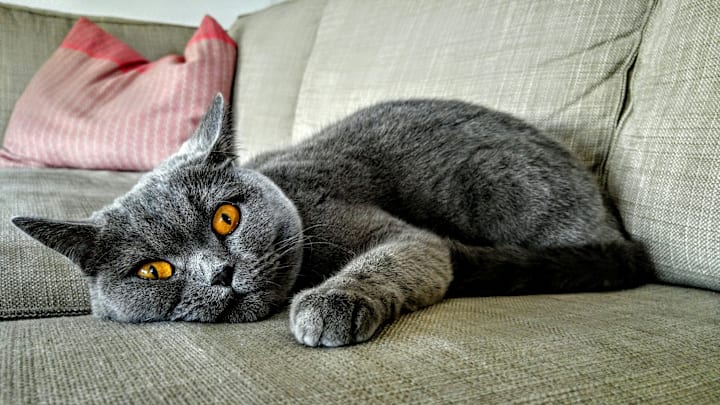Don’t mistake Chartreux cats for British shorthairs. With their plush blue-gray fur and round faces, the two cats look a lot alike. However, the Chartreux is thought to hail from France, where it’s unofficially known as the country’s national cat. Here are seven facts about the elegant Gallic kitty.
1. The Chartreux’s origins are unclear ...
Like most cat breeds, there are colorful (and potentially mythical) tales surrounding the Chartreux’s origins. The most enduring explanation is that the Chartreux’s ancestors were feral mountain cats from the Middle East. During the 13th century, merchants or Crusaders brought the cats to France.
It’s said that Carthusian monks later bred the cat at the Grande Chartreuse Monastery in southeastern France. The monks have distilled a liqueur called Elixir Végétal de la Grande-Chartreuse from herbs, plants, and flowers since 1737, so the gray kitty was called the Chartreux after their famous alcohol. However, monastery records don’t mention the Chartreux cat, so the jury’s still out on whether this romantic story is true.
Meanwhile, others say the feline received the name “Chartreux” thanks to their thick, wooly coats, which look similar to a Spanish wool called la pile de Chartreux.
2. ... But it’s lived in France for centuries.

While experts don’t know where the Chartreux comes from, they say it’s lived in France for a very long time. In 1558, French poet and critic Joachim du Bellay wrote a poem called “Vers Français sur la mort d’un petit chat” (“French verse on a small cat's death”). The verse mourns a tiny gray kitty’s untimely passing—a cat that many people believe to be a Chartreux. He wrote:
“Here lies Belaud, my little gray cat,
Belaud, that was the most handsome perhaps
That nature ever made in cat’s clothing.
This was Belaud, death to rats.
Belaud, to be sure his beauty was such
That he deserves to be immortal.”
And in 1747, French portrait artist Jean-Baptiste Perronneau painted an aristocratic woman, Magdaleine Pinceloup de la Grange, holding a large cat with gray fur. Thanks to its distinctive coloration and build, art experts say that the feline is a Chartreux. Many naturalists, historians, and writers have also mentioned the elegant cat in their works.
3. The Chartreux breed was threatened by World War II.
Like many feline breeds, the Chartreux cat’s existence was threatened after cat fanciers stopped breeding it during World War II. To save it, breeders outcrossed the Chartreux with cats including Persians. Today, you’ll still occasionally see a poufy Chartreux appear in a litter of shorthaired kittens if both of its parents carried the recessive gene for long fur.
4. The Chartreux is a relatively new breed in America.

The Chartreux didn’t officially make it to America until 1970, when two cat lovers named Helen and John Gamon from La Jolla, California, read about the Chartreux in a book and wanted to purchase one for themselves. The couple traveled to Paris, where they bought two Chartreux cats. The Gamons brought the kitties back to America, and discovered that there were no other Chartreux kitties registered in the U.S. and Canada. They seized the opportunity to import even more of the beautiful blue felines. Today, those two individuals are thought to be the likely progenitors of all Chartreux cats in the U.S. [PDF]. Eventually, the Cat Fanciers’ Association (CFA)—the world’s largest registry of pedigreed cats—gave the breed full recognition in 1987.
5. The Chartreux is subtly different from the British blue.
Many think that the Chartreux and the British shorthair are the same, but if you look closely, you’ll spot subtle differences between the two felines. For instance, the British blue’s coat is short, plush, and extremely dense, with a crisp feel to the touch. In contrast, the Chartreux’s water-repellent fur has a shorter undercoat, a longer topcoat, and is slightly tufted and woolly.
Meanwhile, British shorthairs’ eyes can be copper, green, gold, and blue. A Chartreux cat’s eyes are brilliant orange. And while both cats are stocky and have round, “grinning” faces, the Chartreux has fine-boned legs. Thanks to this trait, some cat fanciers lovingly refer to the Chartreux as a “potato on toothpicks.”
6. The French writer Colette loved Chartreux cats.

French author Colette owned several Chartreux cats, including a feline named Saha. The cat inspired Colette to write a short novel, 1933’s La Chatte, about a man named Alain who loves his Chartreux cat—also named Saha—more than his wife. In the book, Colette’s affection for the breed shines through: She lovingly describes Saha as a “pearl gray devil” and a “little bear with fat cheeks and golden eyes.”
7. Chartreux cats are famously quiet.
According to legend, the Carthusian monks selectively bred Chartreux cats so they wouldn’t interrupt the monks’ meditation. This explanation for the felines’ muted meow is likely more fictional than fact-based. However, the Chartreux is known for being a quiet breed. They rarely make noise, and when they do, they chirp and trill.
A version of this story originally ran in 2016; it has been updated for 2022.
